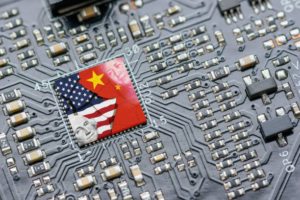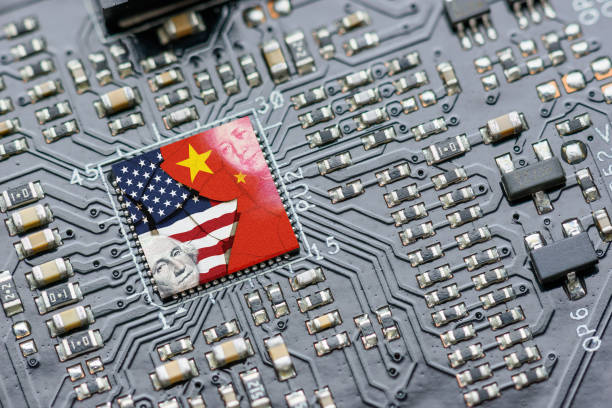By Luke Brzozowski
In 2015, the Chinese Communist Party (“CCP”) released a “state-led industrial policy that [sought] to make China dominant in global high-tech manufacturing.”[1] The program, referred to as “Made in China 2025” (“MIC”), attempted to “mobilize state-owned enterprises and pursue intellectual property acquisition to catch up with—and surpass—Western technological prowess in advanced industries.”[2] These “advanced industries” included technology, pharmaceuticals, and rare-earth minerals.[3]
China’s focus on these industries generated global concern due to commercial technology, such as artificial intelligence and semiconductors, now having significant military value.[4] In 2018, global apprehension eventually developed into reactions that included the U.S. imposing tariffs on billions of dollars of goods from China.[5] Due to these consequences, China’s leaders publicly abandoned MIC.[6] These events ultimately led to the 2020 trade deal between the U.S. and China that required China to commit to increased intellectual property protection for foreign companies, among other legal and economic changes.[7]
Despite this agreement, the relationship between the two countries has continued to deteriorate.[8] Since the deal, Chinese courts and technology companies have adopted new legal tactics to fight claims of intellectual property theft.[9] These methods include forced-transfer agreements and anti-suit injunctions (“ASI”).[10] Thus, because it is unlikely that Chinese courts “deviate from the central government’s policy,”[11] there is unanimity that “the principles behind MIC are alive and well,” meaning the only thing to change was the name of the CCP’s policy.[12]
Since the birth of the CCP in 1949, observers have accused the nation’s courts of hosting show trials[13] and favoring Chinese stakeholders when “strategic sectors or companies . . . are concerned.”[14] Therefore, it is no surprise that recent holdings from Chinese courts appear to align with the government’s agenda of acquiring and controlling trade secrets and IP in these “strategic sectors.”[15] The particular tactics these courts have adopted, however, have sparked widespread condemnation.[16] Not only are these courts overturning patents,[17] but also, they are supporting forced-transfer agreements and using ASIs in an unprecedented manner.[18]
China’s unofficial joint venture policy requires many companies that want to do business in China to enter into agreements with Chinese firms under terms that mandate them to share valuable IP.[19] Many companies comply in order to access “the world’s second-largest consumer market.”[20] This tactic allows China to “leapfrog up global value chains relatively quickly— without the costs, both in terms of time and money.”[21] These forced agreements have ultimately allowed China to “acquire outside technologies ranging from high-speed rail to electric-vehicle batteries.”[22] Therefore, due to the “structural flaws in China’s legal system” that will prevent any deviation from the CCP’s objectives, these barriers to entry are likely here to stay, and a “comprehensive U.S.-style IP protection system will forever remain a mirage in the eyes of foreign corporations.”[23]
In addition to implementing forced-transfer agreements, Chinese courts have begun using ASIs to control IP and licensing rates of important technology.[24] Originating from fifteenth-century England,[25] ASIs are “a controversial instrument used to combat the conflict of jurisdiction and forum shopping . . . [and are] not issued frequently or lightly.”[26] Unlike traditional patents that only extend throughout the jurisdiction of the country that issued the patent, ASIs are typically issued in cases involving standard-essential patents (“SEPs”), which are unique patents that must comply with global standards set by Standard Setting Organizations (“SSOs”).[27] SSOs typically instruct their members to license their SEPs globally on a fair, reasonable, and non-discriminatory basis (“FRAND”), which can result in national courts determining the value of patents issued by other nations.[28] A court that is hearing a SEP claim can issue an ASI to prevent a party from filing in another court and risk having “identical cases playing out in multiple legal venues simultaneously.”[29]
The Intellectual Property Court of the Supreme People’s Court of China issued its first ASI in 2021 in Huawei v. Conversant.”[30] Although other countries have used ASIs in the past, this tactic caught many off guard as ASIs are not explicitly included in Chinese law, nor have the Chinese courts adopted a consistent test to apply it.[31] Since Huawei, Chinese courts have granted ASIs in at least three other major cases[32] but have applied different tests from various common law countries.[33] In addition to the erratic application of ASIs in Chinese courts, China’s rulings have also been “far broader.”[34] China’s ASIs have not been limited to the countries in which the parties sought injunctive relief “but extend to all jurisdictions of the world” and have prohibited litigants from asking any other court to determine global FRAND rates for particular IP by threatening fines up to $1 million per week.[35]
As a result of these ASIs, opposing governments and international organizations have voiced their displeasure and accused China of attempting to unilaterally determine how valuable intellectual property is.[36] In December 2022, the European Union (“EU”) sued China in the World Trade Organization, “complaining that China has barred EU companies from suing to protect their patents in courts outside China.”[37] Over the last two months, Canada, Japan, and the U.S. have all asked to join the complaint.[38] In addition to joining the EU lawsuit, the U.S. has imposed additional restrictions on critical exports to China[39] and recently adopted a new multiagency task force that “aims to protect U.S. technologies” from being stolen by foreign governments.[40]
These countermeasures are intended to protect U.S. innovations, economic competitiveness, and national security.[41] However, the successful implementation of these directives, along with trial proceedings, will take time and will most likely be met with a strong response from the CCP. Thus, as technology rapidly advances and the fight to control this property grows, the strained relationship “between the world’s two biggest economies is only likely to intensify further.”[42]
[1] James McBride & Andrew Chatzky, Is ‘Made in China 2025’ a Threat to Global Trade?, Council on Foreign Rel., https://www.cfr.org/backgrounder/made-china-2025-threat-global-trade (last updated May 13, 2019).
[2] Id.
[3] Stu Woo & Daniel Michaels, China’s Newest Weapon to Nab Western Technology–Its Courts, Wall St. J. (Feb. 20, 2023), https://www.wsj.com/articles/u-s-china-technology-disputes-intellectual-property-europe-e749a72e?mod=hp_lead_pos5.
[4] See McBride & Chatzky, supra note 1.
[5] See Bobby Davis, U.S. to Apply Tariffs on Chinese Imports, Restrict Tech Deals, Wall St. J., https://www.wsj.com/articles/u-s-to-apply-tariffs-on-50-billion-of-chinese-imports-1521723078?mod=article_inline (lasted updated Mar. 22, 2018).
[6] See Emily Crawford, Made in China 2025: The Industrial Plan that China Doesn’t Want Anyone Talking About, PBS (May 7, 2019), https://www.pbs.org/wgbh/frontline/article/made-in-china-2025-the-industrial-plan-that-china-doesnt-want-anyone-talking-about/.
[7] See Josh Zumbrun, China Wields New Legal Weapon to Fight Claims of Intellectual Property Theft, Wall St. J. (Sept. 26, 2021), https://www.wsj.com/articles/china-wields-new-legal-weapon-to-fight-claims-of-intellectual-property-theft-11632654001?mod=article_inline.
[8] See Ana Swanson & Lauren Hirsch, U.S. Aims to Curtail Technology Investment in China, N.Y. Times (Feb. 9, 2023), https://www.nytimes.com/2023/02/09/business/us-china-investing-tech-biden.html?searchResultPosition=22.
[9] See Zumbrun, supra note 7.
[10] See McBride & Chatzky, supra note 1; Andrei Iancu & Paul R. Michel, The Solution to Chinese Courts’ Increasingly Aggressive Overreach, Ctr. for Strategic & Int’l Stud. (Apr. 6, 2022), https://www.csis.org/analysis/solution-chinese-courts-increasingly-aggressive-overreach.
[11] Sophie Tang, Anti-Suit Injunction Issued in China: Comity, Pragmatism and Rule of Law, Conflict of L. (Sept. 27, 2020), https://conflictoflaws.net/2020/anti-suit-injunction-issued-in-china-comity-pragmatism-and-rule-of-law/.
[12] Crawford, supra note 6.
[13] See Edward White, Chinese Courts Flex Intellectual Property Muscle Across Borders, Fin. Times (June 15, 2022), https://www.ft.com/content/d4b4e41b-d303-474e-a084-717b948cf2f8.
[14] Woo & Michaels, supra note 3.
[15] Id.
[16] See id.
[17] See id.
[18] See Yang Yu & Jorge L. Contreras, Will China’s New Anti-Suit Injunctions Shift the Balance of Global FRAND Litigation?, Patently-O, 2020, at 4.
[19] See McBride & Chatzky, supra note 1.
[20] Daniel Rechtschaffen, How China’s Legal System Enables Intellectual Property Theft, The Diplomat (Nov. 11, 2020), https://thediplomat.com/2020/11/how-chinas-legal-system-enables-intellectual-property-theft/.
[21] Nicholas Yong, Industrial espionage: How China sneaks out American’s technology secrets, BBC (Jan. 19, 2023), https://www.bbc.com/news/world-asia-china-64206950.
[22] McBride & Chatzky, supra note 1.
[23] Yong, supra note 21.
[24] See Andrei Iancu & Paul R. Michel, The Solution to Chinese Courts’ Increasingly Aggressive Overreach, Ctr. for Strategic & Int’l Stud. (Apr. 6, 2022), https://www.csis.org/analysis/solution-chinese-courts-increasingly-aggressive-overreach.
[25] Yu & Contreras, supra note 18, at 2.
[26] Tang, supra note 11.
[27] Ken Korea, Anti-suit injunctions–a new global trade war with China?, ManagingIP (Aug. 3, 2022), https://www.managingip.com/article/2afz8grsj5i3uyxp19ji8/anti-suit-injunctions-a-new-global-trade-war-with-china.
[28] Id.
[29] Zumbrun, supra note 7.
[30] Tang, supra note 11.
[31] Id.
[32] Zumbrun, supra note 7.
[33] Tang, supra note 11.
[34] Yu & Contreras, supra note 18, at 4.
[35] Id. at 5; see also Zumbrun, supra note 7.
[36] See Zumbrun, supra note 7.
[37] Woo & Michaels, supra note 3.
[38] Id.
[39] See id.
[40] Ben Kochman, Feds Form ‘Strike Force’ To Protect Tech From Foreign Theft, Lexis (Feb. 16, 2023), https://plus.lexis.com/newsstand#/law360/article/1577284?crid=a03fb10d-e0c9-4709-94b1-19c1bc9abff4.
[41] See Walter G. Copan, China’s Ally in Stealing Western IP: The United States, Ctr. for Strategic & Int’l Stud. (Oct. 26, 2022), https://www.csis.org/analysis/chinas-ally-stealing-western-ip-united-states.
[42] Yong, supra note 21.




